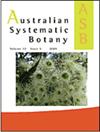基因组掠过提供了清晰的质体和核系统发育,显示了热带食肉植物猪笼草属(石竹目)的深层网状进化模式
IF 1.6
3区 生物学
Q4 EVOLUTIONARY BIOLOGY
引用次数: 15
摘要
猪笼草属是一属肉食性植物,约有160种,分布在古热带地区。由于先前的研究中遗传差异有限,分子系统学迄今未能解决大多数物种的进化关系。在本研究中,我们使用基因组略读方法,基于81个质体基因和高重复rRNA(外部转录间隔区(ETS)-26S),推断了39份材料的系统发育关系,这些材料代表了来自8个部分的34个物种。分别对核数据集和质体数据集进行了最大似然分析和贝叶斯推断。在弛豫分子钟模型的基础上,使用二次校准点进行发散时间估计。核和质体数据集的系统发育分析产生了很好的解析和支持的系统发育。在这两个数据集之间检测到了不一致之处,这表明在该属更深、更近的进化史中存在多个杂交事件或不完整的谱系分类。系统发育分析中包括了几种已知和疑似的杂交种,这为了解它们的亲缘关系提供了线索。分歧时间估计表明,猪笼草的冠部多样化发生在约2000万年前的中新世早期。这项研究表明,基因组掠过提供了清晰的细胞核和质体系统发育,为猪笼草属复杂的进化关系提供了有价值的见解。本文章由计算机程序翻译,如有差异,请以英文原文为准。
Genome skimming provides well resolved plastid and nuclear phylogenies, showing patterns of deep reticulate evolution in the tropical carnivorous plant genus Nepenthes (Caryophyllales)
Nepenthes is a genus of carnivorous plants consisting of ~160 species that are distributed in the paleotropics. Molecular systematics has so far not been able to resolve evolutionary relationships of most species because of the limited genetic divergence in previous studies. In the present study, we used a genome-skimming approach to infer phylogenetic relationships on the basis of 81 plastid genes and the highly repetitive rRNA (external transcribed spacer (ETS)–26S) for 39 accessions representing 34 species from eight sections. Maximum-likelihood analysis and Bayesian inference were performed separately for the nuclear and the plastid datasets. Divergence-time estimations were conducted on the basis of a relaxed molecular-clock model, using secondary calibration points. The phylogenetic analyses of the nuclear and plastid datasets yielded well resolved and supported phylogenies. Incongruences between the two datasets were detected, suggesting multiple hybridisation events or incomplete lineage sorting in the deeper and more recent evolutionary history of the genus. The inclusion of several known and suspected hybrids in the phylogenetic analysis provided insights into their parentage. Divergence-time estimations placed the crown diversification of Nepenthes in the early Miocene, c. 20 million years ago. This study showed that genome skimming provides well resolved nuclear and plastid phylogenies that provide valuable insights into the complex evolutionary relationships of Nepenthes.
求助全文
通过发布文献求助,成功后即可免费获取论文全文。
去求助
来源期刊

Australian Systematic Botany
生物-进化生物学
CiteScore
3.10
自引率
12.50%
发文量
12
审稿时长
>12 weeks
期刊介绍:
Australian Systematic Botany is an international journal devoted to the systematics, taxonomy, and related aspects of biogeography and evolution of all algae, fungi and plants, including fossils. Descriptive taxonomic papers should normally constitute a comprehensive treatment of a group. Short papers on individual species and nomenclatural papers must contain significant new information of broader interest to be considered. The prestigious L.A.S. Johnson Review Series is published. Other review articles will also be considered. All papers are peer reviewed.
Australian Systematic Botany is published with the endorsement of the Commonwealth Scientific and Industrial Research Organisation (CSIRO) and the Australian Academy of Science.
 求助内容:
求助内容: 应助结果提醒方式:
应助结果提醒方式:


